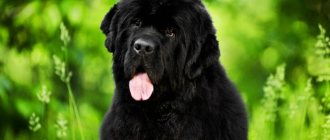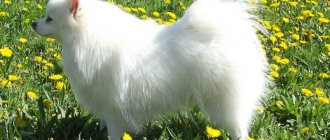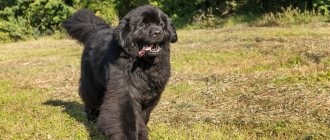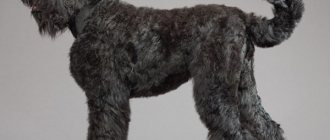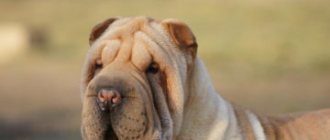Newfoundland - dog breed: breed characteristics, breed standard, height, weight
The main feature of the breed is its large weight and height with good maneuverability and mobility. Dogs, despite their enormous mass, have good control over their bodies. Females are slightly smaller than males. The contours of the head and entire body are more refined. Excess weight is not welcome, as it provokes the occurrence of many diseases.
Characteristics:
- Height for males is 69-75 cm, and for females 65-69 cm
- Weight for males up to 70 kg, and for females up to 55 kg
- Rectangular body with fleshy and strong paws
- The tail is saber-shaped, slightly raised above the level of the back.
- The head is large and characterized by rectangular contours
- The teeth are straight and even, closing like claws or scissors
- The withers are large and developed. For females, its size is not adjustable
Newfoundland - dog breed: breed characteristics, breed standard, height, weight
Newfoundland - history of the dog breed
Newfoundland has been known for a very long time. The first mention of the breed dates back to the 16th century. But the breed received its official name only in 1775.
The breed is named after the island where there was a settlement of fishermen and traders. This island has a humid climate in summer and very cold winters. In these parts, dogs were valued for strength and endurance. This is why the Newfoundland became popular.
Five years later the breed almost disappeared. The fact is that the government has prohibited keeping more than one pet in a family. That is why some of the dogs were taken from the island or destroyed. But the fact is that the residents were not ready to give up their assistants. This is due to the fact that dogs pulled heavy sleds in the cold season, helped pull heavy nets with fish out of the water, and even saved their owners from drowning.
After the First World War, the number of heads was only 23. Therefore, the resulting puppies were quite weak due to blood ties. Now the breed is not very common, this is due to the huge size of the individuals. The breeding of these dogs is carried out by a special club, which is located in Canada and the USA. It is thanks to this club that the breed has survived to this day.
Newfoundland - history of the dog breed
Historical reference
The birthplace of the breed is considered to be the island of the same name, which is located in the possession of Canada. There are several theories about the origin of Newfoundlands. Some believe that their ancestors are the Berenbeitzers, which were common in Europe in the Middle Ages and became the progenitors of the mastiff.
The famous Swiss dog handler Albert Heim claims that Newfoundlands descended from Molossians who came to the island along with the British. It is assumed that the blood of black shepherd dogs and former Pyrenean mountain dogs flows in the veins of the divers. Allegedly, it was from them that the black and white color of Newfoundlands originated. It is believed that aboriginal representatives of dogs, which the Eskimos used for riding, took part in the formation of the breed. From them, divers could have inherited their friendliness and desire to help people.
The first descriptions of the breed date back to the eighteenth century. Back then it was called the “Big Dog of St. John.” The dogs' excellent abilities for long swims, as well as their good nature, were noted. The British took the dogs from the island and began actively breeding them. Initially, animals with black and white colors were used for it. But after that they began to give preference to black dogs.
Newfoundland photo
At exhibitions in 1860 and 1862 in England, this breed delighted everyone. In 1864, the Newfoundland, whose owner was none other than the Prince of Wales, took first place at the exhibition. A year later, the first breed standard was adopted. Divers began to gain popularity in European cities, and in 1885 the first club for fans of this breed appeared in America.
At the beginning of the twentieth century, more and more Newfoundlands began to appear in the homes of the Russian aristocracy. In the fifties of the last century, representatives of this breed began to be brought to the USSR from Germany.
Webbed feet in the Newfoundland dog breed: photo
This breed is a rescue breed. Dogs love water and will not miss the opportunity to swim. The breed is jokingly called the diver. Dogs have membranes between their toes that help them swim and thrive in the water.
Webbed feet in the Newfoundland dog breed: photo
Webbed feet in the Newfoundland dog breed: photo
Possible diseases
Newfoundlands have two breed-specific conditions: hip dysplasia and heart defects. As a rule, heart disease in dogs is congenital. Dysplasia can affect one joint or both, have a mild form or complete dislocation of the femoral head. The disease requires veterinary intervention.
In addition, joint diseases include panitis, an inflammation of the long bones. It usually affects young individuals up to one year old. Unofficially, the disease is referred to as intermittent claudication, which goes away on its own over time. In addition, eye diseases are not uncommon, most often these are entropion of the eyelids, internal and external.
They injure the cornea, causing the eye to become inflamed. In this case, surgery cannot be avoided. Another ophthalmic disease is third eyelid prolapse, where red tissue grows in the inner corner of the eye.
Most often it affects puppies. In this case, you need to completely remove the lacrimal gland. After the operation the Newfoundland , which belongs to the show class, will no longer be allowed to participate in exhibitions.
This large breed often suffers from bloating. As a preventive measure, a diet is suitable, ignoring legumes and any food that can cause fermentation. It is important not to overfeed the dog. Bloating is a companion to volvulus, a fatal disease. To avoid illness, the dog should not be chased after eating; it is better to let it rest.
Newfoundland dog breed: character
The dog has a friendly character. He has an innate instinct to save and pull a drowning person out of the water. The dogs get along well with children and are easy to train. If desired, a dog can be trained to be a watchman. You shouldn't get a dog if you have a very small child in your family. This is due to the fact that dogs at a young age cannot adequately assess their strength. In adolescence, dogs are very energetic and can simply drag a child or an elderly person along with them. Mature dogs are adequate and strong. They can already walk side by side near the owner and evaluate their strength.
It is worth understanding that the dog has high intelligence, he is able to make decisions on his own and can simply ignore an empty or meaningless command. There is no need to break the dog and prove who is first in the family, since the dog is friendly. You don’t need to punish him, just show him that you are offended and disappointed. This dog is not suitable for guarding or hunting. He enjoys looking after children and carrying heavy bags.
Newfoundland dog breed: character
How does a Newfoundland cope with a change of owner?
This breed does not tolerate changing owners well. In a new family, he may become withdrawn and not respond to the commands of the new owner. Therefore, if you need to transfer the dog into new hands, come visit the future owner several times a week. This way the dog will get used to the new owners and will more easily cope with the breakup with the previous owner.
How does a Newfoundland cope with a change of owner?
When does a Newfoundland go into heat, how long do Newfoundlands live?
The first heat in a female dog occurs at the age of 6-12 months. At the same time, the dog may be restless. The duration of estrus is 7-28 days. Mating is allowed for females from 20 months, and for males from 18 months. Previously, you should not mate dogs, as this is fraught with consequences.
The Newfoundland doesn't live long. The average life expectancy is 8-10 years.
When does a Newfoundland go into heat, how long do Newfoundlands live?
What to feed a Newfoundland, what vitamins to give?
It is recommended to give puppies and adults both dry food and natural products. There is a table indicating the norms of proteins, fats and carbohydrates for a dog per day. Many dog breeders recommend giving their dogs natural products. It is better to serve meat boiled. Basically, a dog's diet should consist of dairy products, meat and cereals. Vegetables are introduced boiled. It is also recommended to give sea or river fish. Feeding is carried out twice a day in the morning and evening. A dog needs approximately 800-1000 g of meat products per day. This is beef, lamb or chicken. In addition, calcium and vitamin preparations are introduced into the diet. They recommend 8 in 1 vitamins for dogs.
What to feed a Newfoundland, what vitamins to give?
Health
The main task of the breeder is to select a pair in such a way that sick dogs are not born.
The main weak point of Newfoundlands is their joints, as the puppy grows and gains weight very quickly.
At 1 month they weigh 5 kg, at 2 months - 10 - 12 kg, at 3 months - 15 - 18 kg, and then increasing - up to 65 kg, so the load on the joints is enormous. Proper raising of the dog is of great importance.
Another weak point is the heart. There is such a genetic disease - stenosis. It is incompatible with life. All puppies are tested at 8 weeks to determine if they have this disease. The breeder should not sell such puppies, shifting the responsibility to the new owners.
How to keep and care for a Newfoundland in an apartment?
Dogs can also be kept in an apartment. To do this, allocate a place for your new pet and put a sleeping bag there. The place should be protected from sunlight. This is due to the fact that the dog can get heatstroke. A dog in an apartment will shed little by little throughout the year. Be prepared for the fact that your dog drools a lot, so you will have to wash the floor and clean it frequently.
You need to walk your dog 2-3 times a day. With a small puppy about 4 times a day. At the same time, you need to walk in an active mode. A jog in the forest would be a good idea. Take your dog for a swim in the river.
How to keep and care for a Newfoundland in an apartment?
Breeding and raising puppies
Experienced breeders do not recommend breeding Newfoundlands at home. It cannot be said that these animals require any exceptional conditions of care, but small “divers”, as a rule, require an extremely balanced diet to strengthen the body. Inexperienced owners are rarely capable of such feeding, especially if we are talking about a litter with several puppies.
If you decide in advance that the animal will not be used for breeding, it is recommended to castrate the individual. Castration is believed to increase the potential lifespan of animals.
The very first estrus in female Newfies begins between six months and a year, but it is recommended to wait up to a year until the female’s body is fully formed and strengthened for bearing and giving birth to puppies. That is why mating is recommended only for the second or, better yet, third heat.
Particular attention should be paid to protecting the female in heat from other non-pedigreed males during walks. It is usually not recommended to breed a female with a male from private hands; for this you can contact specialized nurseries where there are purebred males raised specifically for these purposes
Before mating, make sure the animal is healthy
Particular attention should be paid to excess weight in females, which complicates the birth process itself. During pregnancy, the female will need enhanced nutrition with an increased amount of vitamins and minerals
For the birth itself, you should choose a dry place with dim light. At birth, Newfie puppies are practically defenseless, so at first it is recommended to leave them with their parents. After a few days, when the puppies are a little stronger, they should be separated from their mother and placed in a separate room (this should only be done if you decide to sell the puppies).
Important! Puppies should get their first nutritional elements from their mother’s milk, then they will have to switch to more high-calorie and nutritious food, which will be discussed below. Since most purebred puppies are purchased only at the age of 2 to 3 months, keep in mind that during these 2 months all care for the condition of the pets will be on your shoulders
Best Newfoundland dog names: list
List of the best nicknames: Alf, Amanda, Annabelle, Baxley, Baxter, Baloo, Barney, Barry, Black, Boy, Bagheera, Betty, Wolf, Harry, Hector, General, Greta, Dexter, Jazz, Jasper, Jack, Jackson, Jeffrey, Jumbo, Jessie, Ginny, Zulu, Zora, Irta, Cliff, Kara, Carrie, Cassie, Leroy, Lina, Lucy, Magnus, Mutley, Maxi, Melba, Margot, Nadar, Otis, Pumbaa, Rico, Rufus, Roxy, Ruby, Samson, Sebastian, Simba, Sumo, Sam, Stella, Teddy, Thor, Turbo, Tara, Ursa, Fred, Phil, Flora, Hulk, Harley, Hogan, Hugo, Tsunami, Chief, Chulo, Cherry, Sheila, Sheriff, Sherry, Annie.
Newfoundland dog breed: reviews from owners
All owners of such dogs adore their pets. The dog is very positive, she is always in a good mood. At the same time, the dog never gets bored and does not require a huge amount of attention. It is enough to talk to the dog and walk it periodically.
It is worth noting that the negative point in keeping such a dog is:
- Constant drooling
- Snoring while sleeping
- Constant shedding
- Difficulty in washing paws, as dirt gets clogged in the membranes
- Frequent digestive problems
But all these shortcomings are compensated by the positive qualities and friendliness of the dog.
Newfoundland dog breed: reviews from owners
The Newfoundland is a special dog that requires special care and feeding. But this is one of the friendliest breeds, which is ready to help at any time.
Care
The most pleasant procedure for a dog is daily brushing. Beautiful long hair and thick undercoat have the property of annual self-renewal
For this it is important to choose the right tool
If this moment is neglected, then it will be almost impossible to comb out balls of tangled old fur. In this case, it is necessary to trim them, which will not have a very good effect on the appearance.
Trimming and grooming are not allowed if the dog is being taken to a show, but it can make grooming much easier. You can wash with shampoos as needed so as not to remove the protective layer.
Brushing your teeth is also considered an integral part of care. Trimming nails. Checking and cleaning ears and eyes.
